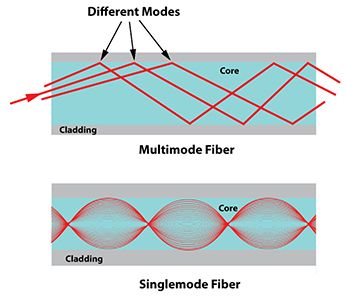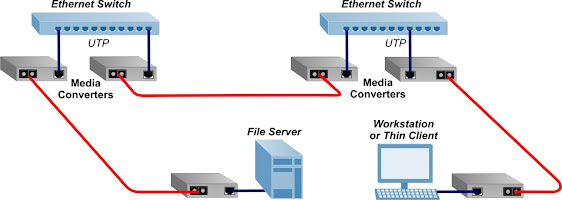Fiber optics networking, is normally expensive and fragile. Telecoms-grade equipment come to mind. Maybe we even have a broadband fiber to the house (helpfully called FTTH). This usually ends in a telecoms-supplied box, Passive Optical Network (PON) into which we plug out usual copper (ie RJ45 UTP) LAN cable.
 |
| Fiber broadband usually ends in copper LAN connection |
But why would I even want fiber for home LAN? Regular readers will know my house is on a hill which regularly gets struck by lightning. We get used to being off-grid for the duration of the storm, which happily is not usually long. But it would be nice not to have damaged electronics. Even better if we can cut over to UPS and keep watching IP TV or youtube. If my copper LAN cable runs are too long (maybe 30m) lightning often damages the network switches, or even fuse the UTP connectors together.
 |
| A Huawei ONT 'fiber modem' commonly supplied with Unifi fiber broadband |
Or you might want more reliable and secure links for your security cameras/CCTVs which are often outdoors and at the end of long cable runs. Maybe you want to share your neighbor's broadband connection.
Or maybe you simply want to speed up/secure that wireless WiFi repeater for when you are at one end of the garden. High speed WiFi is well and good, but once your neighbors have theirs installed the airways can get pretty crowded.
Fiber LAN often means using telecoms equipment which are not only expensive but often not available to the general public. First, the fiber optic cable. Your best chance would be to use the type that your local telecoms monopoly/behemoth uses. High manufacturing volumes usually mean lower prices. Here in Malaysia it is G.657 Class A single mode fiber. A 1000m roll of outdoor cable costs less than RM200 (USD50) and even RM100 (USD25) if you are willing to order from mainland China. That is comparable to a 300m roll of copper Cat 5 UTP LAN cable.
 |
| 1km roll of G.657 Class A single mode fiber |
But fiber cable is more fragile? Yes, if you used the equivalent indoor drop cable. The outdoor cable is often extremely strong. Mine consisted of not one but 3 steel cables reinforcing the fiber cable. I have had tree branches pulling it almost to the ground and the fiber core remained unbroken. They are often stronger than the copper UTP cables.
 |
| Outdoor fiber cables are often extremely strong |
The outdoor fiber cable is far more heavy but they are still smaller than the Cat 5 or 6 copper cable. It is surprisingly bendable, considering fiber optics is a glass. And since there is no ohmic contact, you can run the cable parallel to the mains cables, in the same cable trays or conduits. This greatly reduces cabling costs.
 |
| Most indoor fiber is limp and frail |
OK, but what about the fiber optic interface to the computer? A single mode single core fiber cable specifications are something like this:
The last line reads 850/1300nm: it carries just 2 light frequencies. If you need more channels you need to run another cable. The traditional multi-mode cables carries lots of frequencies, but with a price tag to match.
 |
| Poor cousin: single-mode versus multi-mode fiber |
We will be needing something to convert between UTP and fiber: two fiber modems, one at each end. As usual the Chinese have something cheap and cheerful (only RM25/USD5) called a media converter: the HTB-3100.
Now this being a Chinese no-name box, be careful to look for a media converter that has only one fiber SC UPC port. The picture above shows two (marked TX and RX) but only the TX port can be uncovered. If you, like me, happen to buy the dual-port box by mistake you will need to lay 2 fiber cables for every copper UTP connection. You want to look for WDM (Wavelength Division Multiplexing). To carry 2 channels in one fiber, it transmits in one wavelength, 1550nm and receives at another, 1310nm. That is Type A. Type B is just the reverse, transmitting at 1310nm and receiving at 1550nm. You will be needing one unit of each type. They are often sold in matched pairs.
Both the single fiber and dual fiber media converters might be labelled as Half/Full Duplex. My guess is this refers to the UTP (ie RJ45 or copper) end. These days most CAT5 or CAT6 copper LAN cables come with both TX and RX pairs, and Half Duplex might be when Ethernet is negotiated down to CSMA/CD.
Last but not least there is the complex matter of cutting, splicing and terminating your fiber optic cable. Years ago, it took expensive equipment, highly-trained operators and extremely clean conditions, which are sometimes difficult to do on-site. But for now there is and end-run, a workaround. Again from the Chinese. You can buy the cables already terminated for very low prices. Like RM36 for 50m. That is just USD9.
 |
| Pre-terminated outdoor single mode fiber cable. |
Some suppliers will do it to a custom length. Just make sure the connector is SC UPC (it is easy to specify the incompatible SC APC or LC connectors). Now I had coax 10Base2 concealed LAN wiring installed in my house (yes, yes I am a dinosaur), so it was an easy matter to rip it out of the conduits and install the smaller fiber cable in it place.
The aim is to replace your long copper cable runs with fiber. One benefit is if the cable run is over 100m you do not need to install the repeaters (ie LAN switches) that UTP Ethernet needs. If you add in the cost of the power wiring, enclosures, the savings quickly pile up.
 |
| The aim is to replace long copper LAN cable runs with fiber (in red) |
It worked so well I ran another 100m fiber cable outdoors to my home office so I can share the broadband. The system has been in place through several violent thunderstorms and one fallen tree and did not miss a beat.
If you live in Malaysia, you are in luck, for Talikom Malaysia, the telecoms monopoly mostly uses sub-contractors to install your FTTH fiber cable. For a very reasonable fee, not exceeding the cost of a roll of fiber cable, they can be persuaded to do your internal house fiber cabling. In my case it was money well spent for much of the work involved climbing onto the roof. A huge advantage is they will splice and terminate your fiber cable using proper equipment, resulting in a very good connection.
The only thing left would be an inexpensive way to cut, join and terminate a fiber cable myself. But that is for another post.
Happy Trails.



Searching for the best fiber optic cable manufacturer ? Look no further than Nova Cable. We deliver high-quality, reliable fiber optic solutions designed for optimal performance and durability. Our extensive range of cables meets the needs of various industries, ensuring seamless connectivity and superior data transmission. Trust Nova Cable to enhance your network infrastructure. Contact us today for more information!
ReplyDelete